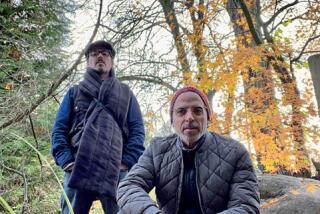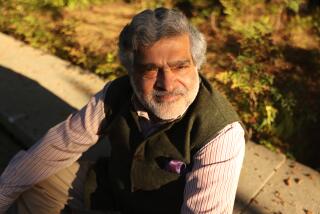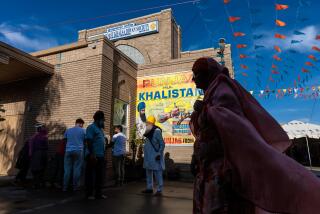A Gandhi-like force for peace
- Share via
NEW YORK — Blood-DRENCHED stories about suicide bombings, armed clashes and assassinations that pour from Pakistan’s tribal belt these days, while stressing the eruption of Taliban-Al Qaeda-related conflict, often also define the regional culture as one steeped in violence for centuries. But what rarely gets told is how the people of the wild west of Pakistan also share the modern history of radical nonviolence.
Little known in the West is a figure named Abdul Ghaffar Khan, who argued that religiously justified violence was “not God’s religion.” Known as Badshah (also spelled Baacha) Khan to his followers, the devoutly Muslim leader was called “The Frontier Gandhi” and built an Islamic parallel to Gandhi’s violence-eschewing ideals of compassion for one’s enemies and peaceful resistance to oppression as a means of overcoming it.
Khan, a Pashtun tribal leader who died at 98 in 1988 in Peshawar, also founded the Awami National Party, which today fights against enormous odds to organize tribal aspirations in the North-West Frontier Province of Pakistan and nearby areas away from the Taliban. The ANP website -- awaminationalparty.org -- carries an image of Khan’s long-nosed, serene face at the top. On Oct. 2, Asfandyar Wali Khan, Khan’s grandson and the president of the ANP, survived a suicide bomb attack outside Peshawar that killed four others.
On Nov. 8, the first full filmic account of Badshah Khan’s exceptional life will get its American premiere in New York at the Mahindra Indo-American Arts Council Film Festival, an art film showcase mounted by a group that includes novelist Salman Rushdie on its advisory board. The documentary, titled “The Frontier Gandhi: Badshah Khan, a Torch for Peace,” is the work of filmmaker and writer T.C. McLuhan, daughter of the Canadian media theorist Marshall McLuhan, who spent 21years to bring the story to the screen.
A restless, determined woman, McLuhan -- she’s called Teri -- made numerous trips to Afghanistan and other places where the Badshah Khan story unfolded, even as American bombs fell in Taliban-held Afghanistan after 9/11 and through the dangerous times that followed. She shot the film in India, Pakistan, Afghanistan and the North-West Frontier Province, giving this story of filmmaking persistence a geopolitical dimension not many can match. Just her tale of transporting two canisters of film stock from Los Angeles across several South Asian borders becomes a saga.
She says she made six trips over the winding Khyber Pass. She dug into archives Afghan film officials sheltered from the Taliban. She managed impossibly smooth tracking shots on rutted streets using a makeshift dolly her Indian cinematographer built with skateboard wheels. A warlord became her guide and appears with her in production stills, standing in a rugged Afghan gully. She had her equipment thrown into the street by police. And she kept going back, using her Canadian citizenship and a widening network of connections to make her account of South Asia’s least known great man.
For McLuhan, 62, the finished film completes a journey that started in September 1987 in Berkeley, when an acquaintance gave her “Nonviolent Soldier of Islam,” a book by the late Eknath Easwaran, who knew Khan.
McLuhan says her long commitment to her project grew from her feeling about Khan’s “uncommon greatness. And that was accompanied by, certainly, uncommon courage. I felt a depth of spirit that I simply wanted to know more about.”
She’s sitting in her Manhattan editing studio with a poster of Woody Allen’s “Annie Hall” (her father made a memorable cameo in the movie) on a wall. The slightly built McLuhan speaks of her filmmaking adventure as if it was all somehow fated. She says that, upon receiving Easwaran’s book, “I looked at it and thought, ‘I don’t know anything about this part of the world,’ and three weeks later, at about 3 in the morning, I picked it up and felt all the electrons around me shift.”
South Asian luminaries she interviewed included Afghan President Hamid Karzai, whose memory of meeting Khan as a boy is one of the film’s most intimate moments, and former Pakistani President Pervez Musharraf, who makes it clear he doesn’t view Khan as a Pakistani patriot (which Khan really was not, given his quasi-nationalistic ideal of a Pashtun homeland).
McLuhan has made two other films, one a fictional tale about twins -- she is a twin -- called “The Third Walker.” She also made “The Shadow Catcher,” a documentary about photographer Edward S. Curtis, and has written several books. She refers to Khan, whom she never met, as “BK,” as if they were close friends.
As a sweeping narrative of a charismatic pilgrim’s progress, “The Frontier Gandhi” has both actual history and certain qualities in common with Richard Attenborough’s 1982 epic film “Gandhi,” in which Khan plays a minor role. McLuhan follows the arc from Khan’s start as the member of an aristocratic family in Charsadda, a town in the Peshawar Valley, to the disappointment his universalist ideals met -- as also happened with Gandhi -- with the partition of India.
“As a young boy,” Khan once said, “I had violent tendencies. The hot blood of the Pashtuns ran through my veins. We have an abundance of violence in our nature.”
McLuhan uses an actor representing a generic (and sinister) British official to recite historical accounts of how the British empire used its military “streamroller” in the tribal areas to play the “great game” for regional influence against Russia. The British ignored the general welfare of the Pashtun people. Like Gandhi, Khan cultivated nationalistic fervor in the soil of deprivations, including poor education and hunger. He convinced villagers that the old ways of feuds and vendettas thwarted collective progress.
At 20, he opened a local school, making education the root of broader reforms. McLuhan says he started to develop his nonviolent philosophy before meeting Gandhi, after a sort of vision that she never quite details. “There is nothing surprising in a Muslim or a Pashtun like me subscribing to the creed of nonviolence,” he says, in a line from McLuhan’s film (the voice speaking Khan’s words throughout the picture belongs to Indian actor Om Puri). “It was followed 1,400 years ago by the Prophet all the time he was in Mecca.”
Khan founded a group called the Khudai Khidmatgar, or servants of God, known as the Red Shirts for the red cotton clothing worn by members, who defied ancient local and religious divisions to join. “The more conservative figure for how many there were at their height is the one I say -- more than 100,000,” McLuhan says. “Others have said more than 300,000. There were representatives of many different tribes. Muslims, Hindu, Sikh, Christian and Buddhist.”
McLuhan recounted how she gathered and filmed 82 former Khudai Khidmatgars, five of them women, many in their 90s: “One of them had saved his complete uniform.” In one interview, we hear how Khan taught people from a warrior world that their oppressors “may kill, but we won’t. They may harm us, but we won’t harm them.”
“Do you know the one word BK used when asked to define nonviolence?” McLuhan asks with hushed intensity, eyes wide with a delight that often infuses them when she speaks of her hero. “ ‘Nonviolence,’ he said, ‘is patience.’
“Most certainly the heart of the film,” she continues, is the “tone poem” she wove of those at-the-camera faces of the Khudai Khidmatgars as they passionately, in six languages, including Urdu and Pashto, speak the oath they learned when they were being jailed and tortured by the British for following Khan, who spent about two-thirds of his life imprisoned by British and then Pakistan authorities who feared his influence.
The oath turns into verbal music, the English translation orchestrated over the still-audible voices. (The music was overseen by composer-performer David Amram.) “I am a Khudai Khidmatgar,” it begins. “And as God needs no service, serving his creation is serving him. I promise to serve humanity in the name of God.”
Khan, offered the leadership of the Indian National Congress during India’s independence fight, rejected it to avoid becoming a purely political figure. It was a larger focus shared by Khan and Gandhi, who were personally close.
Unlike Gandhi, Khan did not leave a large written record or become a media sensation. But McLuhan found photos of them together that are surprising for their glow of mutual warmth. The petite Gandhi is joined by an Islamic sage who stands towering and sinewy in simple cotton clothing, his gentle-fierce aura something like Gandhi’s -- only different.
How, one wonders, can Khan be so little known? In the film, M.J. Akbar, one of India’s best-known journalists, gives McLuhan an answer: “The market for nonviolence was so used up by Mahatma Gandhi there was no space left for an alternative Gandhi, for a second Gandhi. You know, this is one of the problems of media -- that even history becomes an exercise in brand building. So the brand was built around Gandhi, and not on Badshah Khan.”
More to Read
Only good movies
Get the Indie Focus newsletter, Mark Olsen's weekly guide to the world of cinema.
You may occasionally receive promotional content from the Los Angeles Times.










